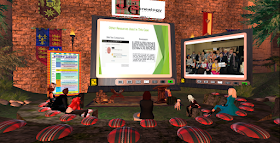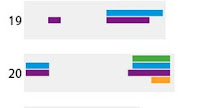 |
| Just Genealogy in Second Life (an Official site for Global Family Reunion) had presentations in support of Global Family Reunion, and raised money for Alzheimer's |
I listened to the Livestream from SCGS's Jamboree, and the Global Family Reunion last weekend. Both events provided interesting information and entertainment. The Global Family reunion was outstanding. Very entertaining. Some great comedy between presentations. They got a jab in at Ancestry. One comedian said it seems like every ancestor, for example, is a whaling captain according to Ancestry's commercials. But someone had to steal the horses too?
Prof. Gates announced he is helping to create a curriculum using DNA testing for middle school students.
You can watch recorded videos from Global Family Reunion here: Free Videos http://livestream.com/GlobalFamilyReunion
Video from Jamboree Livestream Free:
http://livestream.com/wab/live1
Audio Jamboree Pay $11 per session: http://www.myconferenceresource.com/products/44-02-scgs-dna-jamboree-conference-2015.aspx
Some of the sessions I listened to and my thoughts about them.
Ross Curtis, PhD Ancestry DNA- The Latest Innovations in DNA Technology and Science and What They Mean for You
This session contained some interesting info. A study was done by Ancestry comparing the DNA of cousins to see how often small segments were shared. According to the presenter when you compare the DNA of 3 first cousins they will all share a small 5 cM segment 85% of the time. With 5 first cousins small segments were shared 40% of the time. When they compared 10 first cousins they didn't find that any of these shared the same small segment (must have been a different group?). In the case of the 3rd cousin level small 5 cM segments are shared about 15% of the time (the other scientists in the study couldn't believe it was really as high as 15% of the time. This is the mentality we are dealing with at Ancestry). With 4th cousins it's practically zero percent who share the small segments.
This scientist said you can't use segments of DNA to find a common ancestor? Actually that is what they are doing. They are using trees, plus shared DNA to form the Circles. He also said specific segments cannot bring people together? So what are the Ancestral Discoveries about?
If I were there I would have asked more hard hitting questions than the audience did. Some of the softball questions regarded things like profile photos not displaying properly? The only possible hope of getting something out of Ancestry Circles would be if they added more features so we can analyze the quality of the matches. He didn't sound confident about providing any more information. I would at least like to know the size of the segments I share with someone, plus how many segments we share, at the very least.
If we test every relative we meet we can strengthen the Circle matches (plus empty our pockets). Not interested. He also stated that when they create Circles each person is given a score based on the likelihood they share the Circle ancestor. They look at the information shared in common on the trees. They also look at how complete the trees are. If a person doesn't have a very complete tree, containing enough identifying information they won't likely have many, or any, Circles. One reason for this is that Ancestry has discovered something many of us have, we can share more than one family line with a match. When Ancestry's analysis finds more than one possible relationship to members of a Circle they can't place you in a Circle; no way to know which Ancestors you got the DNA from. If your tree is mostly empty they can't evaluate whether you could be related another way, so this could keep you out of Circles too. This is all complicated, and leaves many people out of the Circles. I would say the Circles I have are correct for me. The Ancestry Discoveries are all cousins, or in-laws.
Listening to the Ancestry spokes holes is pretty aggravating. Of course the presenter, who developed the Circles, has 73 Circles (he did say the fact he developed them has something to do with that). Some of his Circles are weak, so he is not certain if he is really related the way some of the Circles imply. The best way to confirm that is with traditional research, instead of testing more relatives.
The way this Ancestry scientist was talking they don't believe anyone who tests with Ancestry is capable of understanding the science of genetics. At one point he said I hope I didn't lose you? Maybe I'm pretty stupid to have tested with them? He may be right.
Thank god the photo issue is being worked on (he's a scientist so that's no his job, as he told the audience member). He also didn't know whether maintaining a subscription was required to keep access to the DNA results (odd he didn't want to talk about the particulars of that).
I've tested with 23andMe recently and hope to get better results over there.
Kathy Johnston, MDC
Adventures Around the World with X, Y, and Mitochondrial DNA
This was an interesting presentation. I'm interested attempting to figure out family migrations using DNA also. She demonstrated that the X chromosome can be useful.
Thomas W. Jones, PhD, CG, CGL, FASG, FUGA, FNGS
Debunking Misleading Records
Really made me think about the quality of my sources. We really have to consider whether documents we are basing conclusions are the best sources with the most accurate possible information. Also we need to consider whether a document may have been tampered with? Of course clerks were prone to mistakes, like all of us, so even official records contain wrong information. Informants providing information on documents often provide some wrong details.. All of this means you can't rely on any one document alone.
Thomas W. Jones, PhD, CG, CGL, FASG, FUGA, FNGS
Can A Complex Research Problem be Solved Solely Online?
Fascinating case study was presented to demonstrate what can be done online. Can a complex problem be solved solely online? "Yes but..."
Blaine T. Bettinger, PhD, JD and Paul Woodbury
Genetic Genealogy and the Next Generation
Interesting presentation. They presented research regarding testing trends. Trends reflect immigration patterns. Interesting they found nearly half of the young people who test for ethnicity find they are more interested in another aspect of their results.
Lisa Louise Cooke
Update: Google! Everything New that You Need to Know for Genealogy
This was an interesting presentation. I learned
Google Earth Pro is now Free. It has extra features which you can use to create tours of ancestral areas. Someone asked a question about operators used to narrow a search with Google search. They asked if phrases such as OR must be capitalized. The answer was yes. When I tried capitalizing using AND with search I got some different results than when I just used the +. I found a Nicaraguan library with a
digital collection which should be helpful.
Dr. Michael D. Lacopo
Methods For Identifying the German Origins of American Immigrants
Interesting presentation packed with information on how to find the Church and Civil boundaries of areas our German ancestors lived in. You can't find the records unless you know the jurisdictions. He also talked about reading the records, which look pretty difficult to decipher. But, like he explained, you get used to the handwriting style of the clerk and certain phrasing for birth, death , marriage, name, are repeated so you'll know exactly what is being referred to. I found, with the Austro Hungarian records, once I got used to the structure of the Church book entries I could understand what was being conveyed, even though I didn't know the language.












